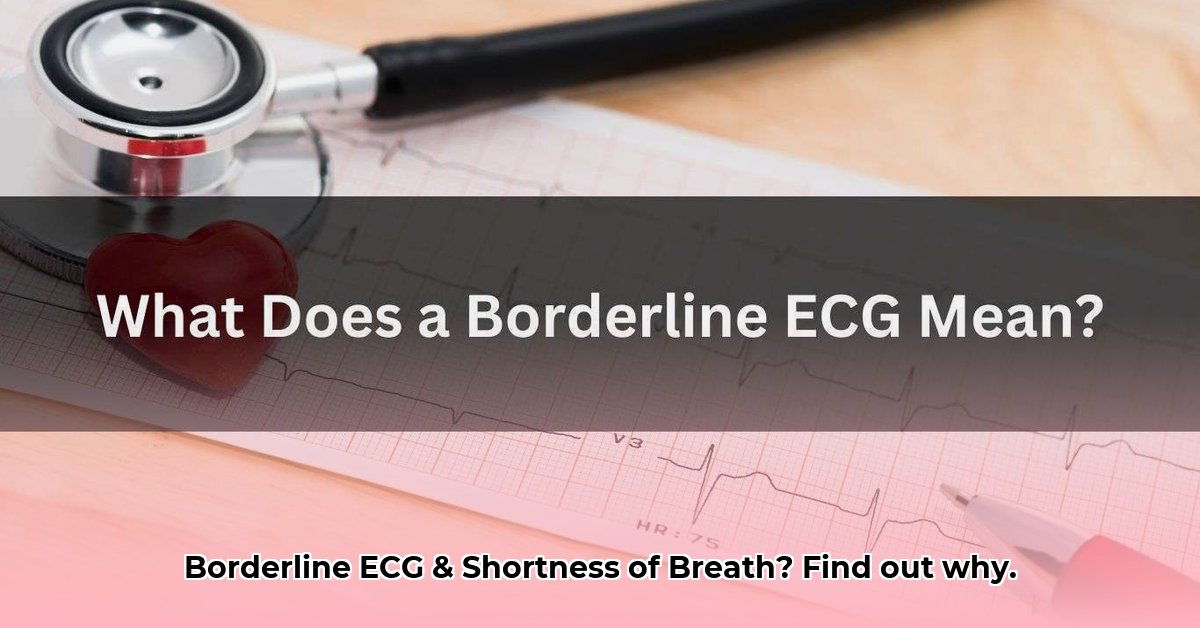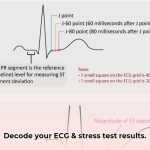Feeling short of breath and getting a slightly unusual result on your heart test (ECG)? It’s understandable to be worried. This guide will help you understand what that might mean. We’ll break down those sometimes confusing ECG results, explain different interpretations, and show you exactly what steps to take next. You’ll learn practical strategies for managing your symptoms and improve your heart health. The goal is to give you the information you need to make informed decisions and get the right care.
Borderline ECG and Shortness of Breath: Initial Steps
Feeling short of breath? And your ECG came back as “borderline”? It’s understandable to feel a little unnerved. Let’s break down what this means and what you should do next. This isn’t a diagnosis itself, but a signpost pointing towards the need for a deeper look into your overall health and potential cardiovascular risks.
Understanding Your ECG: Why It’s Not the Whole Picture (Cardiac Assessment)
An electrocardiogram (ECG) is like a snapshot of your heart’s electrical activity. Think of it as seeing a brief movie clip of your heart working. A “borderline” result simply means the reading isn’t definitively normal, nor is it clearly abnormal. It’s like being in a gray area – not quite sick, but not entirely healthy, either. Lots of things can affect your ECG reading, from everyday stress and what you’ve eaten recently to the presence of certain medications or even an electrolyte imbalance. It’s a valuable tool, but it’s not the ultimate answer when determining the cause of dyspnea (shortness of breath).
What does a borderline ECG paired with shortness of breath mean for you? It means more detective work is needed. Your ECG gives us a glimpse, but to get the whole picture, we need more information. We need to explore what might be causing both your ECG result and your breathing issues.
Why the Uncertainty? The Limits of a Single Test (Diagnostic Limitations)
The reason we don’t always get straightforward answers with a borderline ECG and shortness of breath comes down to the ECG’s limitations. While it’s a powerful diagnostic tool, it’s not perfect. Tiny variations in your heart’s electrical signals can be tough to interpret with absolute certainty. The challenge lies in figuring out if these variations are harmless or point to a larger issue. Think of it like trying to diagnose a car problem from just listening to the engine; you get some clues, but a more thorough check is needed to assess potential cardiac arrhythmias.
Shortness of Breath: It’s Not Always a Heart Thing (Differential Diagnosis)
It’s important to remember that shortness of breath isn’t automatically a heart problem. Your lungs, for instance, could be involved. Conditions like asthma or pneumonia can cause breathlessness. Or, it could be related to anxiety, or even something as simple as anemia (low iron). A borderline ECG along with breathing difficulties requires us to look at the bigger picture and check various possibilities beyond your heart, including pulmonary function and potential respiratory infections. Common non-cardiac causes of shortness of breath include:
- Pulmonary Issues: Asthma, chronic obstructive pulmonary disease (COPD), pulmonary embolism, pneumonia, bronchitis.
- Anxiety and Panic Disorders: Hyperventilation can mimic shortness of breath.
- Anemia: Reduced oxygen-carrying capacity of the blood.
- Obesity: Excess weight can put a strain on the respiratory system.
- Allergic Reactions: Leading to airway constriction.
- Neuromuscular Disorders: Affecting respiratory muscle strength.
What to Do Next: Your Action Plan (Patient Empowerment)
Having a borderline ECG and shortness of breath means it’s time to take proactive steps:
- Talk to Your Doctor: Schedule an appointment to discuss your symptoms and the ECG results. Bring any questions you have. They’ll help make sense of the findings and conduct a comprehensive evaluation. Be prepared to discuss the onset, duration, and triggers of your shortness of breath, as well as any associated symptoms like chest pain, cough, or wheezing.
- Further Tests: Your doctor might suggest more tests to get a clearer picture. These could include:
- A repeat ECG—sometimes, a second look is all you need.
- An echocardiogram—a type of ultrasound of your heart.
- A stress test—to see how your heart reacts to exertion.
- A Holter monitor—a portable device that tracks your heart rhythm over a longer period.
- Pulmonary function tests to check lung capacity and airflow.
- Blood tests to rule out anemia, infection, or electrolyte imbalances.
- Chest X-ray or CT scan to visualize the lungs and airways.
- A Holistic View: Your doctor will consider your whole medical history, your lifestyle, and all your symptoms. It’s not just about the ECG result; it’s about understanding the whole you. Share details about your diet, exercise habits, smoking status, alcohol consumption, and any recent stressors.
- Lifestyle Changes (Possibly): Based on the test results, your doctor might recommend lifestyle changes, such as improving your diet, adding regular exercise, and finding ways to better manage stress. They may also advise on smoking cessation, weight management, and optimizing sleep hygiene.
Risk Factors: Your Personal Equation (Risk Stratification)
Several factors play a role in your risk of heart problems. The table below offers a general guideline, but remember it’s a broad overview. Individual risk can vary significantly.
| Factor | Low Risk | Moderate Risk | High Risk |
|---|---|---|---|
| Patient Age | Under 40, healthy lifestyle | 40-60, some risk factors | Over 60, multiple risk factors |
| Symptoms | None | Mild, general symptoms (fatigue, palpitations) | Severe symptoms (chest pain, severe breathlessness, fainting) |
| Medical History | No significant heart history | Hypertension, diabetes, etc. | Previous heart attack, family history of heart disease, known heart conditions (e.g., heart failure, valve disease) |
| Lifestyle Factors | Healthy diet, exercise, no smoking | Some unhealthy habits | Multiple unhealthy habits |
| Electrolyte Imbalances | Normal levels | Mild imbalances | Significant imbalances |
| Medication Use | No relevant medications | Potentially cardiac-affecting meds (e.g., some antidepressants, decongestants) | Multiple potentially cardiac-affecting meds (e.g., beta-blockers, diuretics) |
| Associated Conditions | No other health conditions that could contribute to shortness of breath (e.g., obesity, lung disease) | Existing conditions like mild asthma or controlled sleep apnea | Pre-existing chronic respiratory conditions (COPD), severe obstructive sleep apnea, known history of pulmonary embolism, recent upper respiratory infection |
| ECG Findings | Borderline ECG with very minimal deviations and no specific concerning patterns | Borderline ECG with more pronounced deviations, such as minor ST-T wave changes or slight QRS complex abnormalities | Borderline ECG showing significant abnormalities or changes from previous ECGs, especially if coupled with concerning symptoms; may show signs suggestive of ischemia or significant arrhythmias |
Remember, a borderline ECG along with shortness of breath calls for a proactive approach. Open and honest communication with your doctor is essential. Together, you can figure out what’s going on and create a plan to keep you healthy. Current research is continuously refining our understanding of heart health, so stay informed and keep those lines of communication open with your healthcare provider.
How to Interpret Borderline ECG Results with Patient History (Comprehensive Assessment)
Key Takeaways:
- A borderline ECG isn’t a diagnosis; it’s a signal for further investigation.
- Your medical history is critical in interpreting these results and understanding potential cardiovascular disease.
- Additional tests are often needed to clarify the findings and rule out serious conditions.
- Understanding your results requires a collaborative approach with your doctor.
- Shortness of breath warrants specific attention and investigation to determine the underlying cause.
What Does a Borderline ECG Mean? (ECG Interpretation)
An electrocardiogram (ECG) measures your heart’s electrical activity. A borderline ECG shows subtle deviations from a perfectly normal rhythm. It’s like a blurry photograph – the main features are visible, but some details are unclear. This doesn’t necessarily mean you have a serious heart problem. Often, these minor variations are unimportant. However, they do require further investigation to rule out anything significant, especially if you’re experiencing symptoms consistent with heart failure, such as leg swelling, fatigue, and persistent cough.
The Importance of Patient History (Clinical
- How Much Do Wellness Programs Cost Businesses To Offer? - December 16, 2025
- Wellness Fair Ideas for Work to Boost Employee Wellbeing - December 15, 2025
- Affordable Employee Wellness Fair Ideas for Any Budget - December 14, 2025
















